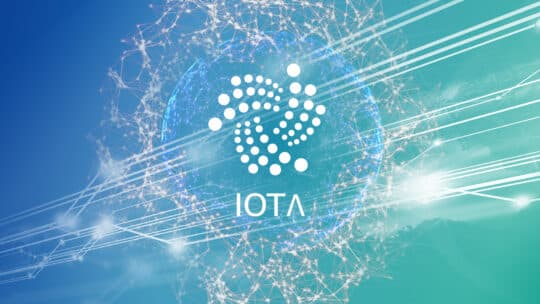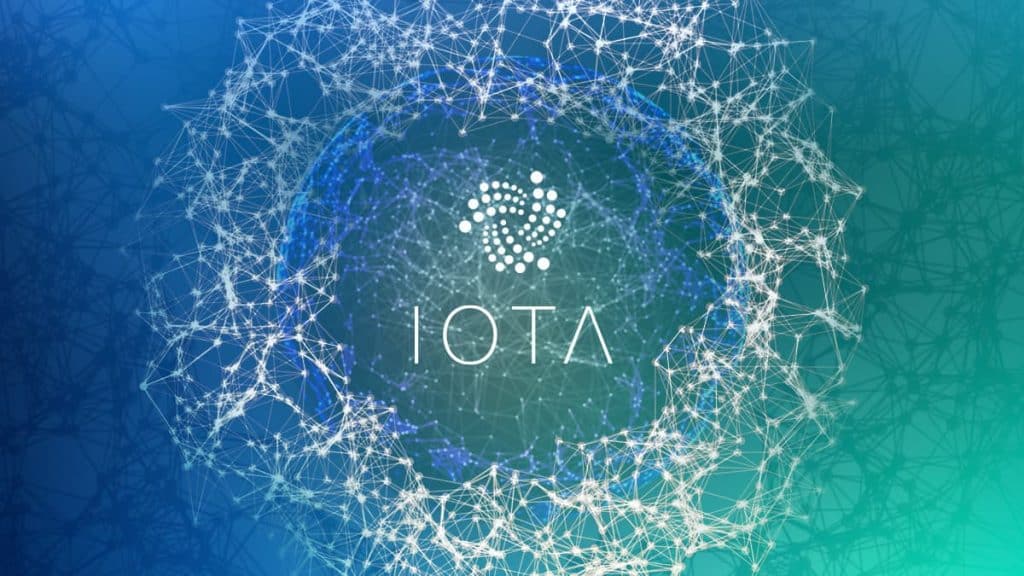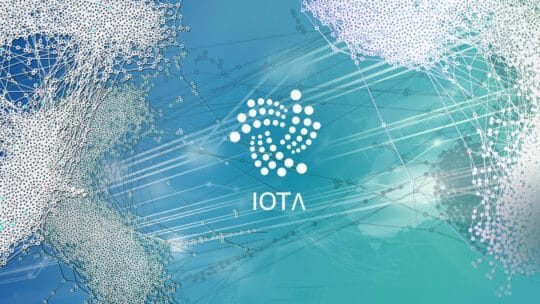IOTA is an open and feeless data and value transfer protocol (and network). The IOTA Foundation has reengineered distributed ledger technology from the ground up, making the secure exchange of both value and data possible. IOTA is open source and doesn’t require fees.
“We actually see the IOTA token as the connective tissue between the human economy and the machine economy – creating interoperability between the two.” – Dan Simerman, Head of Financial Relations at IOTA Foundation
Data integrity and GDPR compliance are central to the protocol. With the IOTA protocol data and value can be exchanged separately. This is one of the main differences to other Blockchains. One of its primary use cases is to serve as an operating system for data and value exchange in the next internet. “We’re building a new internet.” often comes to my mind when I think of IOTA.
Machines will soon be able to exchange services with each other and pay each other for them with MIOTA. M2M (machine-to-machine) is being added to the traditonal B2B (business-to-business) and B2C (business-to-consumer) areas. The Internet-of-Things is constantly growing and consists of small and large machines whose networking is constantly increasing. Dishwashers will soon be able to order tabs and refrigerators food online. But they will not have high computing power in the near future. With IOTA, transactions can be carried out without high computing power, securely and without fees.

Self-driving cars will be able to charge themselves and pay for it directly. Payments of this kind are not effective enough with banks. With an estimated 75 million connected devices on the Internet of Things in 2025, detouring a payment via a bank would mean an immense loss of time and money. Banks as well as most cryptocurrencies require transaction fees, IOTA does not. This unique selling point is technically very difficult to implement. However, anyone who takes a closer look at the IF’s publications knows that it has already been solved mathematically. The technical implementation is far advanced.
The development of the IOTA token is led by the IOTA Foundation (IF). The IF is a non-profit foundation based in Berlin. It aims to improve the world in a sustainable, equitable and transparent way. Since I was a young person, I have dreamed of making the world a better place. With the IOTA community, for the first time I have the impression that we have a realistic chance to do so.
The security of your IOTA tokens
The question “Where are my IOTA tokens safest?” was asked very often on Discord. The answer in most cases was: “On a hardware ledger”. These are physical wallets that look like USB sticks. Buy one from the Ledger shop.
What influences the worth of the IOTA token?
Demand determines the price. The Internet of Things (IoT) is still in its early stages. It’s not difficult to look into its future, though. More and more machines will have processing power plus the ability to connect to the internet. These machines will interact with other machines.
“Imagine billions of IoT devices each having to pay each other small amounts. There currently are about 2.78 billion Miota at roughly 23 cents/Miota. Let’s say that every IoT device will hold on average 1 dollar worth of Iota and there are 2 devices for every human on the planet (14 billion). That means there is no doubt that due to scarcity the Iota price will have to go up, which means that the need to divide into smaller units may approach rather quickly.” – Eric Hop, IOTA Foundation
The IOTA protocol enables individuals as well as companies to monetize their data. For this, the IF built an autonomous and decentralized marketplace. An individual can put up a sensor, gather meteorological data like temperature, air humidity and pressure and feed the data directly into the marketplace. The tangle is open, free and feeless, so anyone can use it.
Organizations all over the world can access this data and pay for it – with the IOTA token. The tangle is free to use, you can use the token, but you’re not required to. Soon enough, it will be possible to wrap Bitcoin in IOTA and trade it without fees.
“Build the use-case first and then mix in the financial ledger. Not the other way around!” – Olaf van Wijk
What determines the IOTA price?
To learn more about how the IOTA price might develop, I recommend the following posts:
“The innovation is the tangle, do we need an IOTA Token?” The value of zero.
“Derivation of Value” on helloiota.com
Will the IOTA price go up?
The IOTA token supply is limited to 2.779.530.283 MIOTA. That is 2.779.530 GIOTA (Giga IOTA) and 2.779 TIOTA (Tera IOTA). Inflation is not planned, the token is designed to increase in value in the long term. The amount of IoT devices and the demand for IOTA tokens may exceed this limited amount in the future. It is technically possible to add 6 more zeros and thus make the currently smallest unit of 1 IOTA divisible. Price is determined by demand, and demand is determined by adaption as in actual usage. With its USP of feeless transactions and being one of the very few green cryptocurrencies, you don’t have to overly strain your imagination to figure out whether IOTA’s price will go up or not.
This is not financial advice, always do your own research.
What about the FUD?
FUD (Fear, Uncertainty and Doubt) comes and goes. The IF has made mistakes regarding the design of the protocol. The Chrysalis update fixed them. Communication wasn’t always optimal, but the foundation is maturing and the sound of the communication is way better than in the past few years.
The complexity of what the IOTA Foundation and community is accomplishing can be overwhelming. If you are in doubt about the intentions or where all of this is leading I recommend the following books. Actually they are Dominik Schiener’s personal reading recommendations. They were mailed to the participants of the IOTA FutureProof webinar The Question of Why?

The Master Switch: The Rise and Fall of Information Empires
I found this book fascinating because it draws the big picture of the beginning and development of mass media. There was a lot of enthusiasm at the beginning of telephone, radio and TV. Many early adopters were certain that it would benefit individuals and communities. Almost all media inventions got monopolized in the long run. Guess who is working on preventing that to happen this time.
Buy on Amazon (Reflink)
The Age of Surveillance Capitalism
Want to know more about how social media and tech giants are using our data? How it is used against us and what we can do about that? Watch Shoshana Zuboff’s videos or grab a copy of her book on Amazon (Reflink).
Built to Last: Successful Habits of Visionary Companies
This will probably resonate the most for founders and CEOs. Perfect for me since we are developing a Deposit Return Scheme based on IOTA. Makes reflecting on our vision fun – and gives insight into how the IF is working.
Buy on Amazon (Reflink)
How does IOTA differ from Blockchain?
IOTA has no transaction fees. The Bitcoin Blockchain adds one block after another to its “chain of blocks”. The current maximum is about 7 transactions per second (TPS). With the IOTA Tangle each transaction confirms two others. The more transactions are confirmed, the faster the network becomes. Since the Pollen update v0.2.2 on July 27th 2020 IOTA achieved a maximum of more than 10k TPS.
You can see the actual current TPS at explorer.iota.org/mainnet. CTPS are Confirmed Transactions Per Second. In May 2020 the comnet (community network) achieved a max of 600 CTPS. Confirmation time for value transactions are around 10 – 12 seconds. Imagine sending someone funds, and they arrive 10 seconds later. Plus, you don’t need to pay any fees.
The first blockchain with its currency Bitcoin (BTC) was developed to become a peer-to-peer electronic cash system. Bitcoin’s concept was developed in response to the 2008 financial crisis. This had exposed the extent of the greed (and inability) of some bankers. The suspicion of middlemen filling their pockets is theoretically solved by a blockchain. Blockchains are chains of entries in a “ledger”. A ledger is a list whose entries cannot be changed afterwards. The blockchain can be downloaded as a file and can be viewed by anyone. Its huge disadvantage is the immense energy consumption.
An entrepreneur from Russia bought two power plants to cover the energy needs of his mining farm. Bitcoin’s narrative shifted to digital gold because it has similar attributes.
- Only minable with considerable effort
- Scarcity / limited availability (maximum just under 21 million bitcoins)
IOTA is different from Bitcoin in several ways:
- IOTA is feeless.
- Instead of a “block chain”, transactions are carried out on the tangle.
- Currently, around 1000 TPS (transactions per second) are possible – instead of 7 with Bitcoin.
- The more transactions are executed, the faster they become.
- The low computing power required makes IOTA currently one of the green cryptocurrencies.
The price of both fluctuates strongly. This high volatility does not facilitate the establishment of IOTA as a means of payment. At the same time, it makes cryptocurrencies a risky investment. Bitcoin’s dominance is a strong factor. When BTC rises or falls, the altcoins usually follow suit.

What is IOTA used for?
Automotive
- Earn money while driving with Jaguar Land Rover
- Automotive Smart Charging Station without transaction fees
- Adaptable insurance to the driving style
Portable devices / smartwatches
- Change to the best provider depending on your location
- Collect data without charges
- Reduce the cost of insurance with fitness
Energy
- Collecting energy and distributing it among neighbours
- Decentralization of networks
- Sell energy with nanopayments
Industry
- Immutable data in the supply chain
- Product IDs
- Safe conditions for quality assurance
Supply chain
- Transparent supply chains for optimum value creation
- Sustainable and verifiable conditions for Fair Trade
- Guaranteed quality with sensor paths
Infrastructure
- Optimizing urban processes (waste disposal, smart bins)
- Share WLAN securely with neighbours
- Connect to Smart city, but retain data sovereignty
Global
- Industrial revolution for all
- Improving production sustainably
- Communication between satellites and planets